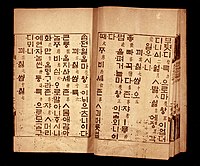
Back Mittelkoreanisch German زبان کرهای میانه Persian Moyen coréen French Coreano medio Galician Középkoreai nyelv Hungarian Bahasa Korea Pertengahan ID Coreano medio Italian 中期朝鮮語 Japanese 중세 한국어 Korean Середньокорейська мова Ukrainian
| Middle Korean | |
|---|---|
 "Songs of the Moon Shining on a Thousand Rivers" (Worin Cheongang Jigok, 1447), a collection of Buddhist hymns composed by King Sejong | |
| Region | Korea |
| Era | 11th–16th centuries |
Koreanic
| |
Early forms | |
| Hanja (Idu, Hyangchal, Gugyeol), Hangul | |
| Language codes | |
| ISO 639-3 | okm |
okm | |
| Glottolog | midd1372 |
| Korean name | |
| Hangul | 중세 한국어 |
| Hanja | 中世韓國語 |
| Revised Romanization | Jungse hangugeo |
| McCune–Reischauer | Chungse han'gugŏ |
| North Korean name | |
| Hangul | 중세 조선어 |
| Hanja | 中世朝鮮語 |
| Revised Romanization | Jungse joseoneo |
| McCune–Reischauer | Chungse chosŏnŏ |
Middle Korean is the period in the history of the Korean language succeeding Old Korean and yielding in 1600 to the Modern period. The boundary between the Old and Middle periods is traditionally identified with the establishment of Goryeo in 918, but some scholars have argued for the time of the Mongol invasions of Korea (mid-13th century). Middle Korean is often divided into Early and Late periods corresponding to Goryeo (until 1392) and Joseon respectively. It is difficult to extract linguistic information from texts of the Early period, which are written using adaptations of Chinese characters. The situation was transformed in 1446 by the introduction of the Hangul alphabet, so that Late Middle Korean provides the pivotal data for the history of Korean.